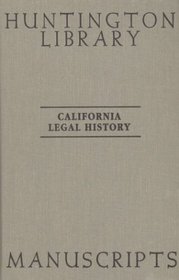Search -
California Legal History Manuscripts in the Huntington Library: A Guide by The Committee on History of Law in California at The State Bar of California
California Legal History Manuscripts in the Huntington Library A Guide by The Committee on History of Law in California at The State Bar of California
Author:
The Huntington Library houses a wealth of material pertaining to legal history. The collections that deal with California law are predominantly from the nineteenth century and involve real estate, agriculture, and industries such as mining, oil, and commerce. For the lawyer of the period, these areas of activity generated a large property and co... more »
Author:
The Huntington Library houses a wealth of material pertaining to legal history. The collections that deal with California law are predominantly from the nineteenth century and involve real estate, agriculture, and industries such as mining, oil, and commerce. For the lawyer of the period, these areas of activity generated a large property and co... more »
ISBN-13: 9780873280990
ISBN-10: 0873280997
Publication Date: 1/1/1989
Pages: 250
Rating: ?
ISBN-10: 0873280997
Publication Date: 1/1/1989
Pages: 250
Rating: ?
0 stars, based on 0 rating
Publisher: Huntington Library Press
Book Type: Hardcover
Members Wishing: 0
Reviews: Amazon | Write a Review
Book Type: Hardcover
Members Wishing: 0
Reviews: Amazon | Write a Review
Genres:
- History >> Europe >> San Marino
- Reference >> Publishing & Books >> Bibliographies & Indexes >> History
- Reference >> Publishing & Books >> Bibliographies & Indexes >> Law
- Law




